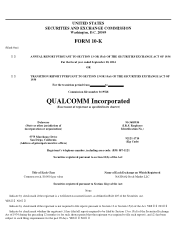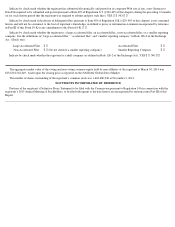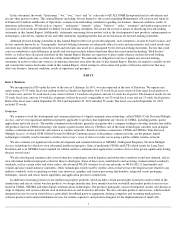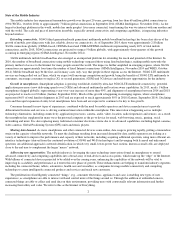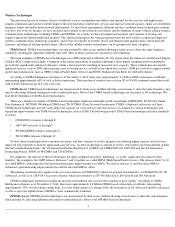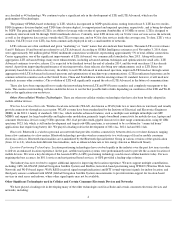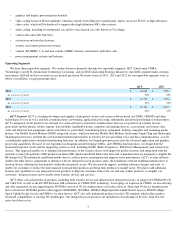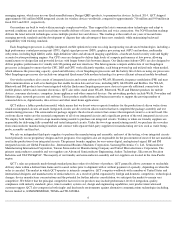Qualcomm 2014 Annual Report Download - page 8
Download and view the complete annual report
Please find page 8 of the 2014 Qualcomm annual report below. You can navigate through the pages in the report by either clicking on the pages listed below, or by using the keyword search tool below to find specific information within the annual report.
Wireless Technologies
The growth in the use of wireless devices worldwide, such as smartphones and tablets, and demand for data services and applications
requires continuous innovation to further improve the user experience, enable new services and increase network capacity, make use of different
frequency bands and enable dense network deployments. To meet these requirements, different wireless communications technologies continue
to evolve. For over two decades, we have invested and continue to invest heavily in research and development of many of these cellular wireless
communication technologies, including CDMA and OFDMA. As a result, we have developed and acquired (and continue to develop and
acquire) significant related intellectual property. This intellectual property has been incorporated into the most widely accepted and deployed
wireless communications technology standards, and we have licensed it to wireless device and infrastructure manufacturers (more than 260
licensees, including all leading manufacturers). Most of the cellular wireless technologies can be grouped into three categories.
TDMA-based. TDMA-based technologies are characterized by their access method allowing several users to share the same frequency
channel by dividing the signal into different time slots. Most of these systems are classified as 2G technology.
The main examples of TDMA-based technologies are GSM (deployed worldwide), IS-136 (deployed in the Americas) and Personal Digital
Cellular (PDC) (deployed in Japan). Compared to the earlier generations of analog technologies, these digital communications technologies
provided for significantly enhanced efficiency within a fixed spectrum, resulting in increased voice capacity. These technologies also enable
enhanced services, such as SMS (short message service) texting service, as well as low-speed data services. GSM has evolved to support mobile
packet data transmission, such as GPRS (General Packet Radio Service) and EDGE (Enhanced Data Rates for Global Evolution).
According to GSMA Intelligence estimates as of November 3, 2014, there were approximately 4.2 billion GSM connections worldwide,
representing approximately 60% of total cellular connections. The transition of wireless devices from 2G to 3G/4G continued around the world
with 3G/4G connections up 24% year-over-year.
CDMA-based. CDMA-based technologies are characterized by their access method allowing several users to share the same frequency and
time by allocating different orthogonal codes to individual users. Most of the CDMA-based technologies are classified as 3G technology. We
lead the development of CDMA-based technologies.
There are a number of variants of CDMA-based technologies deployed around the world, in particular CDMA2000, EV-DO (Evolution
Data Optimized), WCDMA (Wideband CDMA) and TD-SCDMA (Time Division-Synchronous CDMA) (deployed exclusively in China).
CDMA-based technologies provide vastly improved capacity for voice and low-rate data services as compared to analog technologies and
significant improvements over TDMA-based technologies, such as GSM. The following are the CDMA-based technologies and their standards
revisions:
To date, these technologies have seen many revisions, and they continue to evolve, progressively offering higher capacity and data rates,
improved user experiences and new applications and services. As these technologies continue to evolve, new features are being defined in their
relevant standardization bodies, the 3rd Generation Partnership Project 2 (3GPP2) for CDMA2000 and 1xEV-DO and the 3rd Generation
Partnership Project (3GPP) for WCDMA and TD-SCDMA.
For simplicity, the releases of these technologies are often combined and given “marketing” or “trade” names that also indicate their
benefits. One example is the 3GPP releases: Releases 5 and 6 together are called HSPA (High Speed Packet Access). The releases from 7 to 10
are called HSPA+, indicating that they provide performance improvements over HSPA. We refer to releases 11 and beyond as HSPA+
Advanced, again indicating improvements beyond the ones that HSPA+ offers.
The naming convention also applies to the successive releases of CDMA2000, which are grouped and referred to as CDMA2000 1X, 1X
Advanced, as well as to 1xEV-DO successive releases, which are referred to as EV-DO Revision A, Revision B and DO Advanced.
CDMA technologies ushered in a significant increase in broadband data services that continue to grow rapidly. According to GSMA
Intelligence estimates as of November 3, 2014, there were approximately 2.4 billion CDMA-based connections worldwide, representing
approximately 35% of total cellular connections. As of the fourth quarter of calendar 2014, the first phases of 1X Advanced and DO Advanced,
as well as up to the eighth release of HSPA+, were commercially launched.
OFDMA-based. OFDMA-based technologies are characterized by their access method allowing several users to share the same frequency
band and time by allocating different subcarriers to individual users. Most of the OFDMA-based technologies
3
•
CDMA2000 revisions A through E
• 1xEV-
DO revisions A through C
•
WCDMA/HSPA releases 4 through 12
• TD-
SCDMA releases 4 through 12


